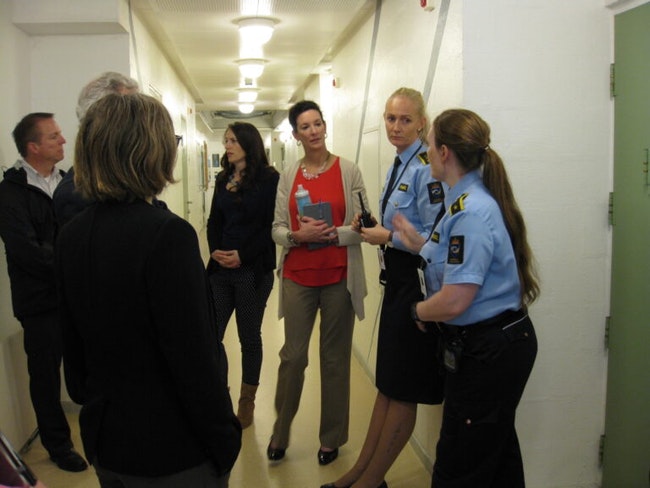
Colette Peters (center), director of the Oregon Department of Corrections director, talks with workers in the Norway prison system during a 2017 research trip to transform Oregon prisons. (Oregon Department of Corrections)
SALEM – Colette Peters, director of Oregon’s prison system, is poised to become the next director of the U.S. Bureau of Prisons.
She has been director of the Oregon Department of Corrections since 2012, overseeing 4,400 employees and 12,124 adults in custody.
Peters confirmed in an interview with the Capital Chronicle that she is a finalist for the federal job.
Michael Carvajal, current federal prisons director, resigned in January but is remaining on the job until his successor is named. Attorney General Merrick Garland makes the appointment and it does not require U.S. Senate confirmation.
“It seems like an incredible opportunity,” Peters said. “I’m honored to be considered to serve in this capacity.”
The Bureau of Prisons has a $7.8 billion budget to run 122 prison facilities with 35,000 employees and 157,000 in custody.
To get the job in a component of the U.S Justice Department, Peters must first clear a federal background investigation. She is the top choice for the job, according to a criminal justice source who is not authorized to speak publicly about a pending appointment.
Peters already has been vetted by federal authorities, who interviewed a range of Oregon officials to evaluate Peters.
‘Highly qualified’
State Sen. Floyd Prozanksi, D-Eugene, said he was contacted last week as part of that work. He gave her a strong recommendation. He chairs the Senate Judiciary Committee, which considers criminal justice legislation.
“She is stellar,” Prozanski said. “She has all the qualifications necessary and demonstrated ability.”
State Sen. Elizabeth Steiner Hayward, D-Portland, said Peters is “highly qualified” for the federal slot.
Peters initiated a series of reforms for the Oregon system to ensure better health among prison workers and more humane treatment of those incarcerated in the state’s 14 institutions.
She came to the job after serving as director for three years of the Oregon Youth Authority.
It was there, she said, that she heard those in incarcerated in the state’s youth facilities referred to as “juveniles in custody.”
Peters modified the phrase when she shifted to the Corrections Department, no longer referring to those in institutions as “inmates” but instead as “adults in custody.” The Legislature subsequently adopted the terminology, replacing “inmate” in state law.
Those and other reforms drew the attention of federal officials, who considered more than 60 applicants for the federal job.
Improving health
Reforms in Oregon included revamping visiting practices and addressing the poor health of prison workers.
Peters said a Minnesota report in 2011 that showed the impact of family visits on those in custody triggered reforms in Oregon. That report found that recidivism rates dropped when adults in custody had more contact with those from outside. She reviewed Oregon’s practices.
“We were conveniently scheduling visits during business hours – convenient for us, not so convenient for families,” she said.
That changed, as well as the environment for such visits that were “scary” for children. Visiting areas were softened, with such elements as wall murals and small furniture for children. Telephone contact, once considered a substitute for visits, became a supplement, Peters said.
Peters also reacted quickly to a state study that for the first time analyzed stress and health among corrections employees. She said she asked for the study not long after she became agency director, wanting to delve into “a rash of suicides among employees.”
Researchers found that 90% of workers were obese.
“One out of two were ready for a heart attack,” Peters said. “They come to work every day in a state of hyper vigilance.”
The Corrections Department implemented steps to get its employees healthy, reducing their stress.
Prozanski said Peters was clearly focused on improving conditions for the agency’s employees.
“She understands how individuals on the line are under extreme pressure,” he said.
A trip to Norway
Prozanski was part of a team of legislators who traveled to Norway in 2017 to study that country’s progressive prison system. He said Peters took to heart lessons from that visit.
Steiner Hayward thought Peters “really was marked” by the experience. The senator noted that in Norway, the maximum sentence is 25 years so the prison system is focused on rehabilitation. Those approaches can work in Oregon, she said, even though not all will be released.
“Many of the adults in custody are going to go back out,” Steiner Hayward said. “We want them to be productive in society.”
Peters said the difference between Norway and Oregon was striking. Recidivism rates were much lower. Employees weren’t overweight.
“I couldn’t find anyone who didn’t love their job,” she said. “It was such a different and healthier and safer environment for the adults in custody and for the people that work there.”
Peters has been implementing lessons from Norway, establishing an approach called “The Oregon Way.”
“The Oregon Way is about prioritizing employee health and wellbeing by normalizing the correctional environment and, in turn, improving the outcomes for incarcerated people,” the agency says on its website. The goal is “humanizing the institution environments for the benefit of employees and the adults in custody.”
This week, a team of behavioral health experts from the Corrections Department is on its own research mission in Norway to learn more.
Prozanski said he watched as Peters incorporated changes to make the Oregon system more humane. He said she took “an aggressive approach to make changes where they have not been effective in the past.”
Steiner Hayward and state Sen. Michael Dembrow, D-Portland, said Peters was trusted at the Oregon Legislature. Dembrow said Peters took criticism well and “when there was a disagreement, she was willing to talk it out.”
Steiner Hayward said when Peters made a good case when advocating for money or program changes at the Legislature.
“We don’t think that she’s coming in with frivolous requests. We don’t think she’s coming in with requests that aren’t well grounded,” Steiner Hayward said.
Peters said she is drawn to the idea of taking Oregon’s reforms national.
“This is an opportunity to take the amazing progressive work that we have done within the Oregon Department of Corrections and share that with a broader organization that will help change the lives of those who live and work in corrections,” she said.
Oregon Capital Chronicle is part of States Newsroom, a network of news bureaus supported by grants and a coalition of donors as a 501c(3) public charity. Oregon Capital Chronicle maintains editorial independence. Contact Editor Les Zaitz for questions: [email protected]. Follow Oregon Capital Chronicle on Facebook and Twitter.




